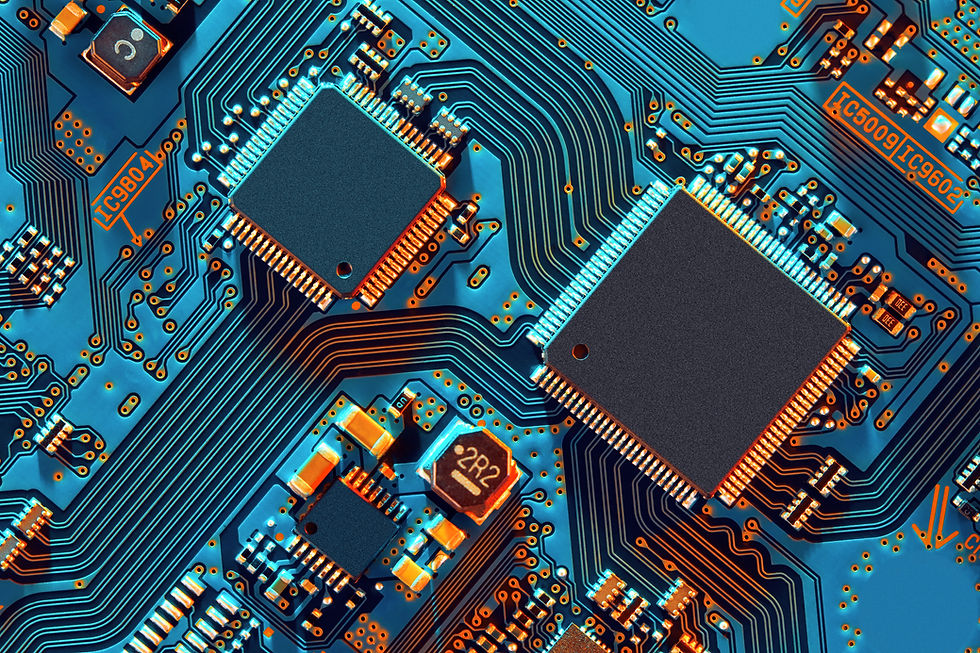Silicon (Si) Metalloid: Prehistory into the Future
- Sylvia Rose

- Dec 1, 2024
- 6 min read
Updated: Mar 10
Silicon (Si) is the second most abundant element in the Earth's crust, next to oxygen. A ductile metalloid, it's integral to industry and natural existence. Silicon is in devices, the environment and the human body. Here are some properties, facts and uses of silicon.

Silicon is first isolated by Swedish chemist Jöns Jacob Berzelius in 1824. Its importance emerges in the late 19th and early 20th centuries with the advent of electrical engineering and the development of the semiconductor industry.
Silica & Silicon
While silicon and silica are closely related, they are not identical. Silicon (Si) is a pure element, while silica (SiO2) is a compound made of silicon and oxygen. Silica is commonly found in nature as quartz. It has industrial purposes especially in glass-making and ceramics.
Silica is the basis for many geological formations. Silicon, as a pure element, has distinct properties exploited in technology.

Silicone & Silicon
While silicon and silicone are often used interchangeably, again the meaning is not the same. Silicon is a natural chemical element, while silicone is a human-made (or robot made) product.
An inert synthetic compound, silicone comes in a variety of forms such as oil, rubber and resin. Typically, heat-resistant and rubber-like, silicones are used in adhesives, cookware, sealants, lubricants, medical applications and insulation.
Silicon is used in transistors invented in in the 1940s, leading to the widespread adoption of silicon in electronics. This is the beginning of the silicon age.

As in many cases, humans have used the element far earlier than its official discovery and/or isolation. Ancient glassmaking uses silica (SiO2, or silicon dioxide) and it's applied to pottery by 3000 BCE. It's used in ancient Egyptian faience.
Faience is a vitreous frit either self-glazing or glazed. The term "faience" covers finely glazed ceramic beads, figures, and other items discovered in Egypt as early as 4000 BC, as well as in the Ancient Near East, the Indus Valley civilization, and Europe.

It's generally found in the form of silicates or silicon dioxide (silica). Silica is an essential material in macrocosmic and microcosmic worlds. It forms the shells of diatoms, types of algae which construct silica shells. These shells are used today in diatomaceous earth.
In contemporary technology and industry, silicon is used in production of semiconductors, essential for the operation of computers, smartphones, and various electronic devices. It's increasingly used in robotics.
It's vital in creating integrated circuits and transistors, which are the core components of all electronic devices. Silicon is important in building materials such as concrete and glass, as well as in solar panels.
Silicon forms the foundation for renewable energy technologies. Its characteristics are crucial across different industries. Silicon is also used in construction materials, glass production, and the silicones found in everyday items.

Scientific & Chemical Properties
Silicon is highly valuable due to its scientific properties. As a semiconductor at room temperature, it shows electrical conductivity that falls between metals and insulators. Its atomic structure allows it to form covalent bonds, resulting in a variety of silicon compounds.
Silicon's melting point is approximately 1,414 °C (2,577 °F), and its boiling point is 2,355 °C (4,271 °F). It has a crystalline structure similar to diamond.

Silicon in Gemstones
Silicon dioxide is commonly found in nature as quartz. It's the most abundant mineral found at Earth's surface, and its properties make it one of the most useful natural substances. In ancient alchemy (by c. 250 AD), one skill of the alchemist is to color quartz to resemble gemstones.
Silicon (Silica) Gemstones & Minerals
Amethyst: Amethyst of vibrant to soft purple is a coveted stone in the quartz group.
Bloodstone: Bloodstone is a member of the chalcedony group.
Agate Chalcedony: Agate chalcedony differs from other chalcedony in that it often has distinct banding.
Chalcedony's standard chemical structure (based on the chemical structure of quartz) is SiO2 or silicon dioxide. Chalcedony has a waxy luster, and may be semitransparent or translucent. It's the basis for many beautiful gemstones.

Medical Uses
The human body contains approximately 7 grams of silicon, which is found in tissues and fluids. In tissues, silicon is typically bonded to glycoproteins like cartilage. In human blood, silicon is primarily present as either free orthosilicic acid or attached to small compounds.
Silicon's biocompatibility facilitates use in various medical applications, especially implants and prosthetics. Silicones give a rubber-like elasticity and stability, found in medical devices, wound dressings and internal drug delivery systems. Silicone is used in breast implants.

In medicine silicon is known through bioactive glass, which contains silica and is used in bone repair and regeneration. This material not only encourages tissue growth but also bonds well with bone, making it a vital component in orthopedic surgery.
Research on silicon-based drugs and materials is ongoing for potential drug delivery systems. Incorporating silicon into therapeutic applications significantly enhances treatment efficacy.
Obtaining Silicon
Silicon is obtained first by mining silica-rich materials like quartz. Processing includes several methods, the most prevalent being carbothermic reduction.
Silicon is primarily extracted through the reduction of silica (SiO2) in electric arc furnaces using carbon as a reducing agent. In this process silica is heated with carbon at high temperatures (1900 °C or 3452 °F).

In this process, quartz is combined with carbon in an electric arc furnace. The extreme heat causes silicon dioxide to separate from oxygen, resulting in pure silicon.
Globally, approximately 7.5 million metric tons of silicon are produced annually, with China accounting for over 60% of the total production. Modern extraction and refining methods produce ultrapure silicon suitable for specialized uses, particularly in electronics.

Alloys Formed by Silicon
Silicon alloys with metals such as aluminum, copper and magnesium, commonly used to enhance mechanical properties of these. The alloys improve properties such as corrosion resistance and flexibility, making them useful in numerous industrial applications.
Silicon in iron and steel production can improve the material’s tensile strength and is commonly used in the manufacturing of high-temperature components. Silicon alloys are used in the automotive sector, contributing to strength and lightness in vehicles.
According to industry data, the use of aluminum-silicon alloys can reduce vehicle weight by up to 10%, significantly improving fuel efficiency. In aerospace, silicon alloys enhance material performance.

Facts about Silicon
Abundance: Silicon is the second most abundant element in the universe by mass after hydrogen. Silicon comprises about 27.7% of the Earth's crust, making it the second most abundant element in the crust, after oxygen.
Silicon Valley: The term "Silicon Valley" refers to the global hub for high-tech innovation and development, named for the silicon-based semiconductor industry.
Silicon in Crystals: Silicon can form a crystalline lattice that gives rise to the structure of various gemstones.
Wide Applications: Silicon is used in semiconductors and integrated circuits, powering the digital age, and its derivatives support advancements in everything from smartphones to solar panels.

READ: Lora Ley Adventures - Germanic Mythology Fiction Series
READ: Reiker For Hire - Victorian Detective Murder Mysteries



